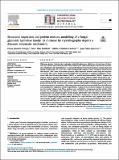Por favor, use este identificador para citar o enlazar a este item:
http://hdl.handle.net/10261/256466COMPARTIR / EXPORTAR:
 SHARE SHARE
 CORE
BASE CORE
BASE
|
|
| Visualizar otros formatos: MARC | Dublin Core | RDF | ORE | MODS | METS | DIDL | DATACITE | |

| Título: | Structural inspection and protein motions modelling of a fungal glycoside hydrolase family 18 chitinase by crystallography depicts a dynamic enzymatic mechanism |
Autor: | Jiménez-Ortega, Elena CSIC ORCID; Kidibule, Peter E; Fernández-Lobato, María; Sanz-Aparicio, J. CSIC ORCID | Palabras clave: | Chitinase Crystal structures Chitin oligosaccharide Binding mode Dynamic mechanism Specificity |
Fecha de publicación: | 2-oct-2021 | Editor: | Elsevier | Citación: | Computational and Structural Biotechnology Journal 19: 5466-5478 (2021) | Resumen: | Chitinases degrade chitin into low molecular weight chitooligomers, which have a broad range of industrial, agricultural, and medical functions. Understanding the relationship between the diverse characteristics of chitinases and their functions is necessary for the improvement of functional enzymes that meet specific requirements. We report here a full crystallographic analysis of three complexes obtained from the chitinase Chit42 from Trichoderma harzianum, which represent different states along the enzymatic mechanism. The inactive double mutant D169A/E171A was submitted to soaking/crystallization experiments with hexa-N-acetyl-glucosamine (NAG6) or tetra-N-acetyl-glucosamine (NAG4), trapping the enzyme-substrate complex (Chit42-NAG6), the enzyme-products complex (Chit42-NAG4-NAG2) and a someway intermediate state. Structural comparison among the different complexes depicts the determinants defining the different subsites and revealed a previously unobserved dynamic on-off ligand binding process associated with a motion of its insertion domain, which might be accompanying the role or aromatics in processivity. An ensemble refinement performed to extract dynamic details from the diffraction data elucidates the implication of some highly flexible residues in the productive sliding of the substrate and the product release event. These positions were submitted to mutagenesis and the activity of the variants was investigated in the hydrolysis of NAG6, colloidal chitin and two chitosans with different polymerization and acetylation degree. All the changes affected the Chit42 hydrolytic activity therefore confirming the involvement of these positions in catalysis. Furthermore, we found the variants R295S and E316S improving the apparent catalytic efficiency of chitin and NAG6 and, together with E316A, enhancing the specific activity on chitosan. Therefore, our results provide novel insight into the molecular mechanisms underlying the hydrolysis of chitinous material by fungal chitinases, and suggest new targets to address engineering of these biotechnologically important enzymes. | Descripción: | 13 pags., 5 figs., 3 tabs. | Versión del editor: | http://dx.doi.org/10.1016/j.csbj.2021.09.027 | URI: | http://hdl.handle.net/10261/256466 | DOI: | 10.1016/j.csbj.2021.09.027 | Identificadores: | doi: 10.1016/j.csbj.2021.09.027 issn: 2001-0370 |
| Aparece en las colecciones: | (IQF) Artículos (CBM) Artículos |
Ficheros en este ítem:
| Fichero | Descripción | Tamaño | Formato | |
|---|---|---|---|---|
| Structural inspection.pdf | 3,07 MB | Adobe PDF |  Visualizar/Abrir | |
| Supporting Information.pdf | 12,13 MB | Adobe PDF |  Visualizar/Abrir |
CORE Recommender
SCOPUSTM
Citations
6
checked on 21-abr-2024
WEB OF SCIENCETM
Citations
6
checked on 25-feb-2024
Page view(s)
29
checked on 24-abr-2024
Download(s)
82
checked on 24-abr-2024
Google ScholarTM
Check
Altmetric
Altmetric
Este item está licenciado bajo una Licencia Creative Commons

